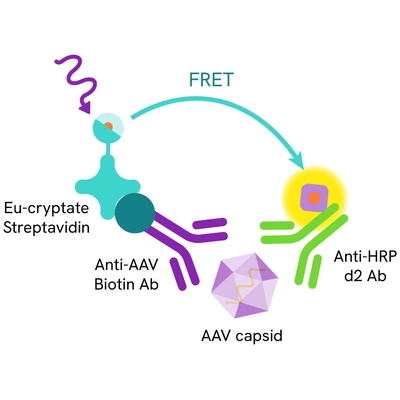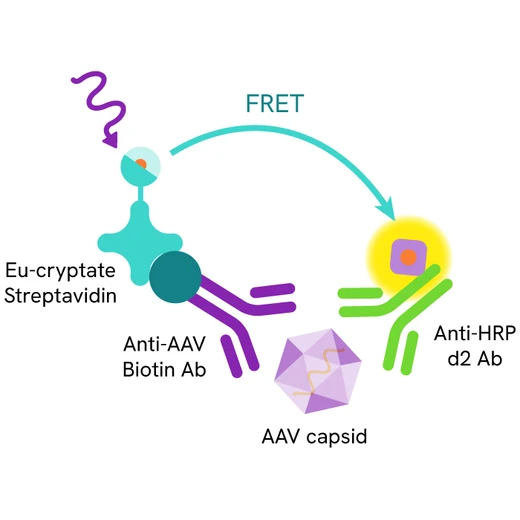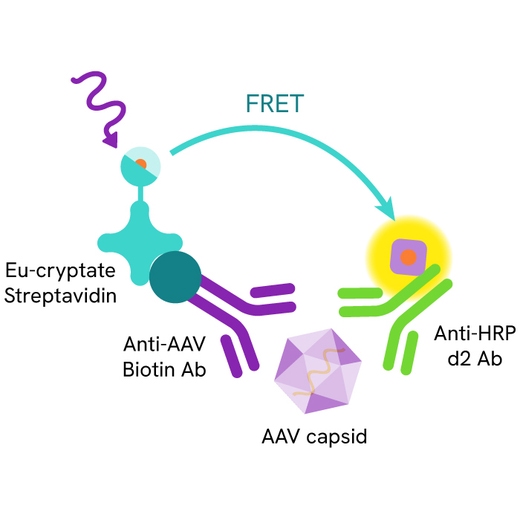

HTRF AAV5 Detection Kit, 500 Assay Points








| Feature | Specification |
|---|---|
| Application | Bioprocessing |
| Sample Volume | 5 µL |









Product information
Overview
Adeno-associated virus (AA) vectors are the leading platform for gene delivery for the treatment of a variety of human diseases. AAV Serotype 5 (AAV5) has been consistently characterized as the serotype with the lowest seroprevalence and minimal cross reactivity against pre-existing neutralizing antibodies which can be an advantage for its use as a vector for gene therapy of hemophilia A and diseases associated with its natural tissue tropism such as lung, retina, or central nervous system cells. The AAV5 kit is designed to detect and quantify AAV5 particles in an easy-to-use, no-wash format. The simple and robust procedure benefits from increased throughput compared to ELISA.
How it works
AAV5 Capsid assay principle
The Adeno-Associated Virus serotype 5 (AAV5) assay measures AAV5 capsid in cell supernatant or cell lysate. The assay uses two antibodies anti-AAV5: one labelled with d2 (acceptor) and the other to biotin that binds to Streptavidin Eu-cryptate (donor) in a premix. In presence of AAV5 capsid in a cell extract or supernatant the addition of these conjugates brings the donor fluorophore into close proximity with the acceptor, and thereby generates a FRET signal. Its intensity is directly proportional to the concentration of the capsid present in the sample and provides a means of assessing any changes caused by experimental variability under a no-wash assay format.

AAV5 capsid assay protocol
The AAV5 capsid assay protocol, using a 384-well small volume white plate, is described on the right. 5 µL of sample or standard and 5 µL of diluent are dispensed directly into the detection plate for detection by HTRF® reagents. The Biotin antibody anti-AAV5 was pre-mixed with Streptavidin labeled with donor before being added. The assay can be run in up to a 1536-well format by simply resizing each addition volume proportionally.

Assay details
AAV5 capsid assay specifications
| Sample size | 5 µL |
|---|---|
| Final assay volume | 20 µL |
| Time to results | Overnight at RT |
| Detection limit (LOD) in diluent | 4.48E+08 VP/mL |
| Dynamic Range | 1.49E+09 – 2.50E+11 VP/mL |
| Sample compatibility |
From raw harvest material to the final product Supernatant, Cell Lysate (LB#3) |

Analytical performance
Precision
Intra-assay
|
Sample |
Mean [AAV5] (VP/mL) |
CV |
|---|---|---|
|
1 |
2.00E+11 |
6% |
|
2 |
5.00E+10 |
2% |
|
3 |
1.25E+10 |
3% |
|
|
Mean CV |
4% |
Each of the 3 samples was measured 24 times, and % CV was calculated for each sample.
Inter-assay
|
Sample |
Mean [AAV5] (VP/mL) |
CV |
|---|---|---|
|
1 |
2.00E+11 |
7% |
|
2 |
3.20E+10 |
8% |
|
3 |
1.28E+10 |
11% |
|
|
Mean CV |
9% |
Each of the samples was measured in 3 independent experiments performed by different operators, and the % CV was calculated for each sample.
Dilutional linearity
|
Dilution Factor |
[AAV5] Expected (VP/mL) |
[AAV5] Mesured (VP/mL) |
Dilution Recovery |
|---|---|---|---|
|
Neat |
- |
2.33E+11 |
100% |
|
2 |
9.31E+10 |
8.89E+10 |
105% |
|
4 |
3.72E+10 |
3.76E+10 |
99% |
|
8 |
1.49E+10 |
1.56E+10 |
96% |
|
16 |
5.96E+09 |
6.52E+09 |
91% |
|
Mean |
|
|
98% |
Interferences
|
[AAV5] (VP/mL) |
[Total Protein] SF9 cell lysates Spiked Sample (mg/mL) |
Recovery |
|---|---|---|
|
5.0E+10 |
0.5 |
126% |
|
0.25 |
120% |
|
|
0.125 |
122% |
|
|
0.05 |
115% |
|
[AAV5] (VP/mL) |
[Total Protein] HEK293 cell lysates Spiked Sample (mg/mL) |
Recovery |
|---|---|---|
|
5.0E+10 |
0.5 |
128% |
|
0.25 |
115% |
|
|
0.125 |
109% |
|
|
0.05 |
115% |
Antigen Spike and Recovery
|
Sample |
[AAV5] Standard (VP/mL) |
SF9 cell lysate (0.05 mg/ml) |
|---|---|---|
|
Recovery |
||
|
1 |
2.05E+11 |
110% |
|
2 |
5.12E+10 |
117% |
|
3 |
1.28E+10 |
112% |
|
|
Mean CV |
113% |
|
Sample |
[AAV5] Standard (VP/mL) |
HEK293 cell lysate (0.25 mg/ml) |
|---|---|---|
|
Recovery |
||
|
1 |
2.05E+11 |
107% |
|
2 |
5.12E+10 |
115% |
|
3 |
1.28E+10 |
104% |
|
|
Mean CV |
109% |
Cross reactivities
|
Empty AAVs Particles |
Cross Reactivity |
|---|---|
|
AAV5 |
100% |
|
AAV1 |
No |
|
AAV2 |
No |
|
AAV3B |
No |
|
AAV6 |
No |
|
AAV8 |
No |
|
AAV9 |
No |
Assay validation
Validation of HTRF AAV5 capsid detection on full and empty AAV5 particles
To demonstrate the detection of both full and empty AAV5 capsids, recognition of full AAV5-CMV-eGFP and empty AAV5 capsids was analyzed in the assay. A large range of AAV5-CMV-eGFP concentration (GC/mL) was calculated in VP/mL using an independent sample quantitation assay. 5 µL of full or empty capsids diluted in the kit diluent were then transferred into a white detection plate (384 low volume), followed by 5 µL of diluent then 10 µL of the HTRF AAV5 capsid detection reagents. The HTRF signal was recorded after an overnight incubation at room temperature. As expected, the HTRF AAV5 capsid detection assay can detect in the same way both full and empty AAV5 capsids.

Specifications
| Application |
Bioprocessing
|
|---|---|
| Brand |
HTRF
|
| Detection Modality |
HTRF
|
| Lysis Buffer Compatibility |
Lysis Buffer 1
Lysis Buffer 2
Lysis Buffer 3
Lysis Buffer 4
|
| Product Group |
Kit
|
| Sample Volume |
5 µL
|
| Shipping Conditions |
Shipped in Dry Ice
|
| Target Class |
Viral Particles
|
| Technology |
TR-FRET
|
| Unit Size |
500 assay points
|
Video gallery
Resources
Are you looking for resources, click on the resource type to explore further.
What Are the Challenges and Solutions?
All across the globe, AAVs are getting the attention of scientists and companies working in...
Discover the versatility and precision of Homogeneous Time-Resolved Fluorescence (HTRF) technology. Our HTRF portfolio offers a...
This guide provides you an overview of HTRF applications in several therapeutic areas.
Neurodegenerative diseases, such as Alzheimer’s, Parkinson’s, and Huntington’s, are complex disorders that affect millions...
See how researchers boost their gene therapy studies with Revvity technologies
The absence or mutation of protein is a factor that...


Loading...
How can we help you?
We are here to answer your questions.






























